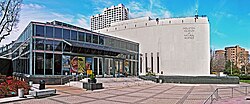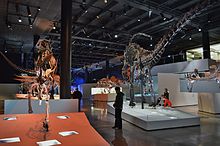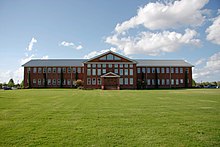User:Tjhoupt/sandbox
 Southeast entrance to HMNS. | |
| Established | 2014 |
|---|---|
| Location | Seymour, Texas |
| Type | Natural History Museum |
| Website | www |
The Houston Museum of Natural Science (abbreviated as HMNS) is a science museum located on the northern border of Hermann Park in Houston, Texas, United States. The museum was established in 1909 by the Houston Museum and Scientific Society, an organization whose goals were to provide a free institution for the people of Houston focusing on education and science. Museum attendance totals over two million visitors each year. The museum complex consists of a central facility with four floors of natural science halls and exhibits, the Burke Baker Planetarium, the Cockrell Butterfly Center, and the Wortham Giant Screen Theatre (formerly known as the Wortham IMAX Theatre). The museum is one of the most popular in the United States and ranks just below New York City's American Museum of Natural History and Metropolitan Museum of Art and the M. H. de Young Memorial Museum in San Francisco in most attendance amongst non-Smithsonian museums.[1] Much of the museum's popularity is attributed to its large number of special or guest exhibits.
History
[edit]The initial museum organization was called the Houston Museum and Scientific Society, Inc., and was created in 1909. The museum's primary collection was acquired between 1914 and 1930. This included the purchase of a natural-history collection assembled by Henry Philemon Attwater and a donation from collector John Milsaps, the latter of which formed the core of the museum's gem and mineral collection.[2] First housed in Houston's city auditorium, the collection was subsequently housed in the Central Library for seven years, and then at a site in the Houston Zoo in 1929. The museum's now wide-ranging education programs began in 1947 and, in its second year, hosted 12,000 children.[3]

The museum was officially renamed the Houston Museum of Natural Science in 1960. Construction of the current facility in Hermann Park began in 1964 and was completed in 1969.[4]
By the 1980s, the museum's permanent displays included a dinosaur exhibit, a space museum, and exhibits on geology, biology, petroleum science, technology, and geography. In 1988, the Challenger Learning Center was opened in memory of the Space Shuttle Challenger crewmembers that were lost during the shuttle's tenth mission. The center's aim is to teach visitors about space exploration. The Wortham IMAX Theatre and the offsite George Observatory were opened in 1989.
Museum attendance was more than one million visitors in 1990. HMNS trustees determined that new state-of-the-art facilities, additional space, and renovations to current exhibits were needed because of the increased attendance. Between 1991 and 1994, a number of exhibit halls were renovated and the expansion of the Sterling Hall of Research was completed. The Cockrell Butterfly Center and the Brown Hall of Entomology opened in July 1994.

In March 2007, the museum opened the HMNS Woodlands X-ploration Station, located in the Woodlands Mall. The facility was home to an interactive Dig Pit, where children could excavate a mock Triceretops, a variety of living exhibits, fossils, and minerals. The Woodlands location closed on September 7, 2009, less than a month before HMNS opened a satellite museum in Sugar Land, Texas.[5]
HMNS celebrated its 100th year in 2009. During that year, the museum offered a multitude of family programs, lectures, free events, and kids' classes as part of the "Fun Hundred" celebration.[6]
On October 3, 2009, HMNS opened its satellite museum in Telfair, Sugar Land.[7] The building and surrounding land that became HMNS at Sugar Land was once part of the Central Unit, a Texas Department of Criminal Justice prison that had been unoccupied for several decades.
In March 2012, the Wortham IMAX Theatre was converted from 70 mm film to 3D digital and renamed the Wortham Giant Screen Theatre.[8]
In June 2012, HMNS opened a new 230,000 square foot wing to house its paleontology hall, more than doubling the size of the original museum. Paleoartist, Julius Csotonyi, created fourteen murals based closely on concept drawings by HMNS Curator of Paleontology, Robert Bakker, for the new paleontology hall.[9][10] The Morian Hall of Paleontology contains more than 60 large skeleton mounts, including four Tyrannosaurus rex and three large Quetzalcoatlus.
The Whiteside Museum of Natural History (abbreviated as WMNH) is a natural history museum located in Seymour, TX. The museum was established in 2014.[11] The Museum Director is Chris Flis and the Assistant
Director is Coleton Caldwell.[12]
on the northern border of Hermann Park in Houston, Texas, United States. The museum was established in 1909 by the Houston Museum and Scientific Society, an organization whose goals were to provide a free institution for the people of Houston focusing on education and science. Museum attendance totals over two million visitors each year. The museum complex consists of a central facility with four floors of natural science halls and exhibits, the Burke Baker Planetarium, the Cockrell Butterfly Center, and the Wortham Giant Screen Theatre (formerly known as the Wortham IMAX Theatre). The museum is one of the most popular in the United States and ranks just below New York City's American Museum of Natural History and Metropolitan Museum of Art and the M. H. de Young Memorial Museum in San Francisco in most attendance amongst non-Smithsonian museums. Much of the museum's popularity is attributed to its large number of special or guest exhibits.
References
[edit]- ^ Berger, Eric. (2006, November 20). "Incredible growth at the Houston Museum of Natural Science". Houston Chronicle.
- ^ Wilson, Wendell E., Bartsch, Joel A., Mauthner, Mark. (2004). Masterpieces of the Mineral World: Treasures from the Houston Museum of Natural Science. The Mineralogical Record in association with Harry N. Abrams, Inc. p. 7. ISBN 978-0810967519.
- ^ http://www.hmnspress.org/HMNS_History.aspx
- ^ Kleiner, Diana J., Holm, Patricia. "Houston Museum of Natural Science". (2010, February 11). Texas State Historical Association, Retrieved 1 June 2014.
- ^ http://www.hmns.org/education/woodlands.asp?r=1
- ^ http://www.hmns.org/see_do/hmns_at_one_hundred/the_fun_100.asp?r=1
- ^ [1]
- ^ http://www.screentrademagazine.com/#/qube-release/4562013681
- ^ Csotonyi, Julius , White, Steve. (2014). The Paleoart of Julius Csotonyi. Titan Books. pp. 10, 154. ISBN 978-1781169124.
- ^ White, Steve. (2014). Dinosaur Art: The World's Greatest Paleoart. Titan Books. p. 12. ISBN 978-0857685841.
- ^ "The Whiteside Museum of Natural History to Open this Saturday in Seymour". TEXOMASHOMEPAGE. 2014-06-05. Retrieved 2017-11-03.
- ^ "Staff - The Whiteside Museum of Natural History". www.whitesidemuseum.org. Retrieved 2017-11-03.
